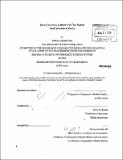| dc.contributor.advisor | Doris C. Rusch. | en_US |
| dc.contributor.author | Diaz, Joshua Lindsay | en_US |
| dc.contributor.other | Massachusetts Institute of Technology. Dept. of Comparative Media Studies. | en_US |
| dc.date.accessioned | 2010-04-28T15:43:11Z | |
| dc.date.available | 2010-04-28T15:43:11Z | |
| dc.date.issued | 2009 | en_US |
| dc.identifier.uri | http://hdl.handle.net/1721.1/54502 | |
| dc.description | Thesis (S.M.)--Massachusetts Institute of Technology, Dept. of Comparative Media Studies, 2009. | en_US |
| dc.description | "June 2009." Cataloged from PDF version of thesis. | en_US |
| dc.description | Includes bibliographical references (p. 215-217). | en_US |
| dc.description.abstract | In designing DwarfFortress as part roguelike and part simulation, Tarn and Zach Adams of Bay 12 Games drew on a tradition of game genres that used proceduralism and simulation to give players unique paths through the game. The specific choices in their design served their goal of "giv[ing] rise to some really awesome stories from the players themselves," I argue, because it took advantage of what Henry Jenkins calls "narrative architecture." Expanding on Jenkins' idea to examine narrative architectures of space, code, and player choice, the thesis shows how Bay 12 not only encouraged players to view the game as a world full of stories, but also gave players tools to craft their own kinds of tellable moments through the game. Tellable moments, as described by Marie-Laure Ryan and Lisbeth Klastrup, are events which, because they either create or break expected patterns, are well-suited to use in plots, and serve as resources for storytelling. As players became authors, they engaged in a sort of 'narrative play' through the game's affordances (and tools created in the community) in order to craft more elaborate and specific story arcs within the general confines of the game. This narrative play is a gameplay strategy in which players use the game's narrative architecture in order to goad the game's code into producing certain kinds of outcomes, outcomes which they aim to use for storytelling. Three different stories provide us with a set of tellable moments in which narrative play alternatively responds to gameplay challenge, creates an environment that embodied and staged story, and reconfigures code in order to create new types of tellable moments. | en_US |
| dc.description.statementofresponsibility | by Joshua Lindsay Diaz. | en_US |
| dc.format.extent | 225 p. | en_US |
| dc.language.iso | eng | en_US |
| dc.publisher | Massachusetts Institute of Technology | en_US |
| dc.rights | M.I.T. theses are protected by
copyright. They may be viewed from this source for any purpose, but
reproduction or distribution in any format is prohibited without written
permission. See provided URL for inquiries about permission. | en_US |
| dc.rights.uri | http://dspace.mit.edu/handle/1721.1/7582 | en_US |
| dc.subject | Comparative Media Studies. | en_US |
| dc.title | Dwarf Fortress gathers at the statue and attends a party | en_US |
| dc.title.alternative | Dwarf Fortress throws a party : social storytelling and complexity | en_US |
| dc.type | Thesis | en_US |
| dc.description.degree | S.M. | en_US |
| dc.contributor.department | Massachusetts Institute of Technology. Program in Comparative Media Studies/Writing | |
| dc.identifier.oclc | 558710326 | en_US |
